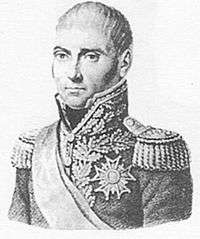Pierre Dupont de l'Étang

Pierre-Antoine, comte Dupont de l'Étang (4 July 1765 – 9 March 1840) was a French general of the French Revolutionary and Napoleonic Wars, as well as a political figure of the Bourbon Restoration.
Life
Revolutionary Wars
Born in Chabanais, Charente, he first saw active service during the French Revolutionary Wars as a member of Maillebois legion in the Netherlands, and in 1791 was on the staff of the Army of the North under General Theobald Dillon.
He distinguished himself in the Battle of Valmy, and in the fighting around Menen in the campaign of 1793 he forced an Austrian regiment to surrender. Promoted to Brigadier General for this accomplishment, he soon received further advancement from Lazare Carnot, who recognized his abilities. In 1797, he became Général de Division.
The rise of Napoleon Bonaparte, whom he supported in the 18 Brumaire Coup (November 1799), brought him further opportunities under the Consulate and Empire. In the campaign of 1800 he was chief of staff to Louis Alexandre Berthier, the nominal commander of the Army of Peierve of the Ains which won the Battle of Marengo. After the battle he sustained a successful combat, against greatly superior forces, at Pozzolo.
Napoleonic Wars
In the campaign on the Danube in 1805, as the leader of one of Michel Ney's divisions, he earned further distinction, especially in the Battle of Haslach-Jungingen (Albeck), in which he prevented the escape of the Austrians from Ulm, and so contributed most effectively to the isolation and subsequent capture of Karl Freiherr Mack von Leiberich and his whole army. He also distinguished himself in the Battle of Friedland.
With a record such as but few of Napoleon's divisional commanders possessed, he entered Spain in 1808 at the head of a motley corps made up of provisional battalions and Swiss troops impressed into French service from the Spanish Royal Army (see Peninsular War). After the occupation of Madrid, Dupont, newly created count by Napoleon, was sent with his force to subdue Andalusia. After a few initial successes he had to retire toward the passes of the Sierra Morena. Pursued and cut off by a Spanish army under the Duke of Castaños, his corps was defeated in the Battle of Bailén after his Swiss troops deserted and returned to their former allegiance. Painfully wounded in the hip, Dupont felt constrained to capitulate. Even so, Dupont sent secret orders to General Dominique Vedel to escape with his division, which was outside the Spanish trap. When the Spanish found out, they threatened to massacre Dupont's men if Vedel did not also surrender, which Vedel did. Altogether 17,600 French soldiers laid down their arms in the disaster. Madrid fell to the resurgent Spanish forces and this soon compelled Napoleon to intervene with his Grand Army in order to salvage the situation.
Disgrace and Bourbon Restoration
Dupont fell into the emperor's disgrace, as it was not taken into account that his troops were for the most part raw levies, and that ill-luck contributed materially to the catastrophe. After his return to France, Dupont was sent before a court-martial, deprived of his rank and title, and imprisoned at Fort de Joux from 1812 to 1814.
Released only by the initial Restoration, he was employed by Louis XVIII in a military command, which he lost on the return of Napoleon during the Hundred Days. But the Second Restoration saw him reinstated to the army, and appointed a member of the conseil privé of Louis XVIII. Between April and December 1814, he was Minister of War, but his reactionary politics made the monarch recall him. From 1815 to 1830, Dupont was deputy for the Charente. He lived in retirement from 1832 until his death in 1840.
Writings
Military treatises
- Opinion sur le nouveau mode de recrutement (1818)
- Lettres sur l'Espagne en 1808 (1823)
- Lettre sur la campagne d'Autriche (1826)
Other
- Poems, including L'Art de la guerre, poème en dix chants (1838), and verse translations from Horace and Homer (1836).
- At the time of his death he was on the point of publishing his memoirs.
Sources
- Glover, Michael. The Peninsular War 1807-1814. Penguin, 1974.
- Smith, Digby. The Napoleonic Wars Data Book. Greenhill, 1998.
- Bicentenario de la Batalla de Bailen
 This article incorporates text from a publication now in the public domain: Chisholm, Hugh, ed. (1911). Encyclopædia Britannica (11th ed.). Cambridge University Press.
This article incorporates text from a publication now in the public domain: Chisholm, Hugh, ed. (1911). Encyclopædia Britannica (11th ed.). Cambridge University Press.- Dictionnaire Bouillet, 1869
References
| Political offices | ||
|---|---|---|
| Preceded by Henri Clarke, duc de Feltre |
Minister of War 3 April 1814 – 3 December 1814 |
Succeeded by Nicolas Jean de Dieu Soult, duc de Dalmatie |
| ||||||||||||||||||||||||||||||||||||||||||||||||||
| ||||||||||||||||||||||||||||||||||||||||||
|